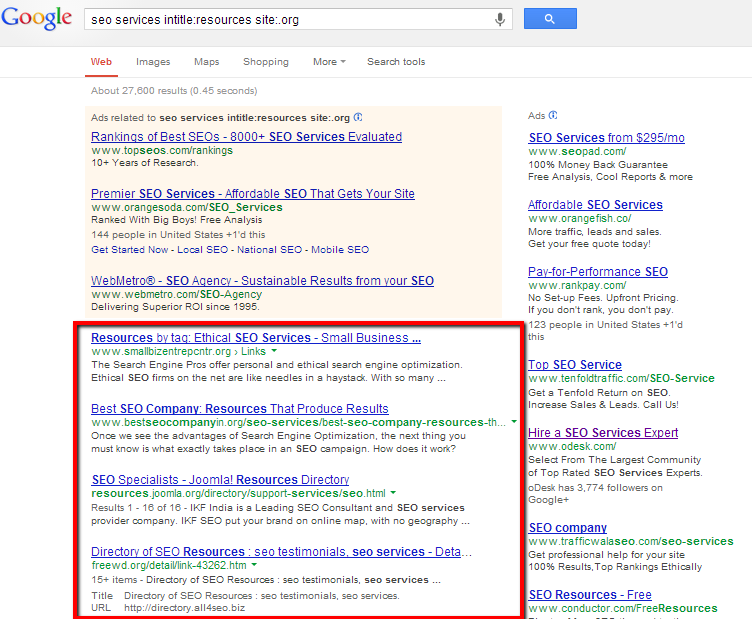Last Updated on February 16, 2022 by Mike
As I’ve noted before, I’m a huge fan of learning new ways to simplify, speed up or automate link building, or finding people who know ways to use a few simple tools that when combined together help streamline the link building process for large scale projects. I utilize one of those concepts that’s probably been covered before, but I thought would be worth sharing. The process is free, it can be done by just about anyone who knows a thing or two about Excel, and it can be done by link builders of all skills or experience.
Using ourselves as an example, it would be great if we could be listed on as many resource pages about SEO services as possible. In order to find these pages, we might start by scouring through the Google SERPs for queries such as “seo services intitle:resources site:.org”.

We could manually go one by one through each page and hopefully identify a few places that we think we could potentially get a link from. That process takes time, and we’d rather just have a nice list of these sites in Excel that we can quickly sort, categorize and associate some quality statics too. We can do this first by scraping the SERP.
1. Scrape Some SERPs
There seem to be plenty of nice scrapers out there that all do about the same thing – This one works well and this one is great for those wanting to export SERP results as a CSV file. You may need to change the number of results displayed to get more results. You can do this by clicking the gear icon in the top right corner of any SERP, clicking “search settings” and then change “Results per page” to 100. It will probably take a few tries to find the right queries that yield the most relevant results. Once you get a decent list of these link prospects in Excel, it’s time to assign them some stats.
2. Gather and Sort by Stats
On it’s own, SEO Tools for Excel is a fantastic (and free) tool that should be added to excel for anyone that uses the internet. You can gather all sorts of information from your prospects including on page information like page titles, meta data and headers. They can even count the number of occurrences of a keyword on a given page. Use their off page features to find a stats of a URL like Google PageRank, and Alexa information. If you have Majestic SEO, you can also link your account and incorporate that information in as well. Once you gather the information that you want (I usually stick to PR, Citation Flow and Trust Flow) just sort your prospects so you tackle the highest quality ones first. For such a great tool, it’s hard to come up with an excuse for not donating.
And that’s about it! I use the URL opener to speed things up, and I have a check mark column for the URLs I’ve reviewed. As you find more prospects, all you have to do is add them in and remove any URL or domain duplicates.

Leave a Reply